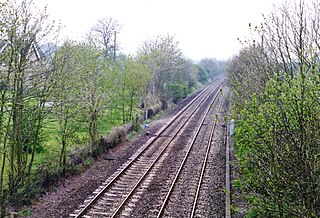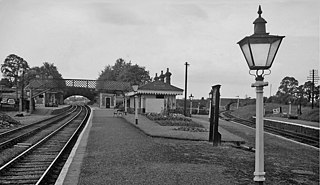The Birmingham and Gloucester Railway (B&GR) was the first name of the railway linking the cities in its name and of the company which pioneered and developed it; the line opened in stages in 1840, using a terminus at Camp Hill in Birmingham. It linked with the Bristol and Gloucester Railway in Gloucester, but at first that company's line was broad gauge, and Gloucester was a point of the necessary but inconvenient transhipment of goods and passengers onto 4 ft 8+1⁄2 in gauge that became the national standard. Nearly all of the original main line remains active as a "trunk" route, also known as an arterial route or line.

Cheltenham Spa railway station is a railway station serving Cheltenham in Gloucestershire, England. Situated on the Bristol-Birmingham main line, it is managed by Great Western Railway and is about one mile from the town centre. The official name of the town is simply Cheltenham, but, when the station was renamed in 1925, the London, Midland and Scottish Railway chose to add Spa to the station name. The station is a key regional interchange and is the fifth busiest rail station in South West England.

Gloucester railway station is a railway station serving the city of Gloucester in England. The station was originally built as the terminus of the Birmingham and Gloucester Railway in 1840, but the arrival of the Bristol and Gloucester Railway and Cheltenham and Great Western Union Railway in 1844, and then conversion to a through station for the South Wales Railway in 1851 resulted in a very complex layout. Subsequent closures and rationalization have left Gloucester with a station that is located off the main Bristol-Birmingham line, meaning Great Western Railway services must reverse, while Cross-Country and Transport for Wales services continue to Newport.

Ashchurch for Tewkesbury is a railway station serving the North Gloucestershire and South Worcestershire Area from the outskirts of Tewkesbury in Gloucestershire, England. The station is located less than 1⁄4 mile (400 m) from junction 9 of the M5 motorway and located on the main Bristol–Birmingham main line 7+1⁄4 miles (11.7 km) north of Cheltenham Spa and was opened on 1 June 1997 by Railtrack. There are regular bus connections from the station to Tewkesbury town centre, which is located two miles to the west. Apart from a few peak journeys on service 41/42, there are no bus connections in the opposite direction from Tewkesbury to Ashchurch.

Cam and Dursley railway station is a railway station serving the village of Cam and the town of Dursley in Gloucestershire, England. It is located on the main Bristol-Birmingham line, between Yate and Gloucester, at a site close to where Coaley Junction railway station was situated from 1856 to 1965.
The Bristol and Gloucester Railway was a railway company opened in 1844 to run services between Bristol and Gloucester. It was built on the 7 ftBrunel gauge, but it was acquired in 1845 by the 4 ft 8+1⁄2 instandard gauge Midland Railway, which also acquired the Birmingham and Gloucester Railway at the same time.
The Oxford, Worcester and Wolverhampton Railway (OW&WR) was a railway company in England. It built a line from Wolvercot Junction near Oxford to Worcester, Stourbridge, Dudley and Wolverhampton, as well as some branches.
The Cheltenham and Great Western Union Railway was a railway company intended to link Cheltenham, Gloucester and Swindon, in England. It was authorised in 1836 but it found it very hard to raise money for the construction, and it opened only a part of its line, between Swindon and Cirencester, in 1841. It sold its business to the Great Western Railway, which quickly built the line through to Gloucester in 1845 and Cheltenham in 1847; part of that route was shared with other companies.

Mangotsfield railway station was a railway station on the Midland Railway route between Bristol and Birmingham, 5.1 miles (8.2 km) north-east of Bristol Temple Meads and 82 miles (132 km) from Birmingham New Street, serving what is now the Bristol suburb of Mangotsfield. The station was opened in 1845 by the Bristol and Gloucester Railway, but had very little in the way of passenger amenities. The station was resited in 1869 to serve the new Mangotsfield and Bath Branch Line, and became an important junction station with extensive facilities and six platforms. Passenger footfall however failed to match the station's size, though at its peak eight staff were employed. The station closed in 1966 when services to Bath ended as part of the Beeching cuts, and the line through the station closed in 1969. The railway became a cycle path in the 1980s, and is a popular resting point on the route as several of the station's walls and platforms are still in situ.
Stroud railway station served the town of Stroud, in Gloucestershire, England. The station was on a short 1.25 mi-long branch from Dudbridge on the Stonehouse and Nailsworth Railway, part of the Midland Railway. It was not connected to the earlier and still used Stroud railway station on the Great Western Railway.

Frocester railway station served the village of Frocester in Gloucestershire, England. The station was on the Bristol and Gloucester Railway, originally a broad gauge line overseen by Isambard Kingdom Brunel, but later taken over by the Midland Railway and converted to standard gauge.

Berkeley Road railway station served the towns of Berkeley and Dursley in Gloucestershire, England.
Wickwar railway station served the village of Wickwar in South Gloucestershire, England. The station was on the Bristol and Gloucester Railway, originally a broad gauge line overseen by Isambard Kingdom Brunel, but later taken over by the Midland Railway and converted to standard gauge.

Berkeley railway station served the town of Berkeley in Gloucestershire, England. The station was on the Sharpness Branch Line, part of the Midland Railway (MR), which connected the Bristol and Gloucester Railway main line at Berkeley Road station with the docks at Sharpness.

The Severn Bridge Railway was a railway company which constructed a railway from Lydney to Sharpness in Gloucestershire, England. It was intended chiefly to give access for minerals in the Forest of Dean to Sharpness Docks, and the company built a long bridge, 1,387 yards (1,268 m) in length, over the River Severn. The line opened in 1879.

The Cirencester branch line was a five-mile-long single-track branch railway line in Gloucestershire, England that connected Cirencester to the main line at Kemble. It was opened by the Cheltenham and Great Western Union Railway in 1841. The main line was extended from Kemble to a junction near Gloucester in 1845, by the GWR which had taken over the C&GWUR. The branch supported a busy passenger and goods business, but these declined in the 1930s, and closure was threatened in the 1950s. To reduce costs and maintain the viability of the line, lightweight four-wheel diesel railbuses were introduced, and they proved popular. Nevertheless, the line's decline was inexorable, passenger service closed in 1964 and the goods service ending the following year.

Cheltenham Spa St. James railway station was a station in the town of Cheltenham.
Cheltenham High Street railway station was built by the Midland Railway to serve the north-western part of Cheltenham.
Tetbury Road railway station was built by the Cheltenham & Great Western Union Railway to serve the Gloucestershire villages of Kemble and Coates, and the town of Tetbury.
The Bristol and Gloucestershire Railway was an early mineral railway, opened in two stages in 1832 and 1834, which connected collieries near Coalpit Heath with Bristol, at the river Avon. Horse traction was used. It was later taken over by the Bristol and Gloucester Railway, and much of the route became part of the main line between Birmingham and Bristol, though that was later by-passed and closed. Part of it now forms the Bristol and Bath Railway Path.












